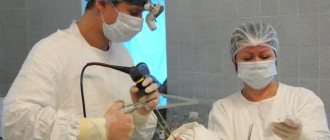Excision of facial scars is represented by plastic surgery measures aimed at eliminating a cosmetic defect using various techniques, the choice of which depends on its characteristics and area of location. The scar itself is a dense connective formation formed during the process of tissue regeneration after:
- surgical intervention;
- skin damage;
- inflammatory processes;
- ulcerative lesions.
It is mainly composed of fibrillar protein, which forms the basis of the connective tissue of the human body and is known as collagen. It is visually different from the tissues it replaces and is not as functional. They resort to removing scars on the face and body because they stand out against the background of healthy skin and spoil the appearance, often being a source of complexes and psychological problems.
Excision of scars (keloid, atrophic) - on the face (1cm) - 14,000 rubles.
Excision of scars (keloid, atrophic) - on the body (1cm) - 8,000 rubles.
Included in the price:
surgery, consultation with an anesthesiologist, anesthesia/anesthesia, hospital stay with meals, dressings, postoperative observation by the attending physician for a month.
1-3 days in hospital
Removal of scars on the face and body in Moscow
Modern plastic surgery offers effective techniques for removing scars on the body and face. You can order services in this area at the plastic surgery department of CELT.
We employ specialists with decades of experience. They have mastered excision techniques and consistently achieve excellent results, restoring beauty to patients. The process uses modern equipment and effective anesthesia drugs.
Particular attention is paid to diagnosis, which allows us to identify and eliminate contraindications and minimize the risk of complications. Our clinic is multidisciplinary and has its own laboratory and diagnostic department. If necessary, our patients can consult with highly specialized specialists in various fields.
To find out the price for removing scars on the face and body, go to the “Services and prices” tab in this section. It is calculated per 1 centimeter and will cost more on the face. To avoid misunderstandings, find out the exact numbers by contacting our operators.
Why is it better to perform surgical excision of a nevus at the Swiss University Hospital?
- We employ specialists with extensive experience, including doctors of the highest category, professors, associate professors, and candidates of medical sciences. If necessary, doctors of narrow specializations are involved in treatment: oncologists, plastic surgery specialists, etc.
- Every year, more than 5,000 patients with various pathologies, including skin diseases, consult our specialists.
- The clinic offers almost all existing modern methods of treating skin diseases in accordance with the traditions of leading European clinics. Each specialist knows more than 100 types of operations within his specialization.
- More than 120 operations are performed in our clinic annually; we guarantee excellent quality and strict adherence to medical technologies.
Preparation for scar excision surgery and its implementation
Since excision is a full-fledged operation (sometimes not an easy one), it requires complex preparation. In addition to attending a preliminary consultation and discussing the desired results with a plastic surgeon, the patient needs to undergo diagnostic tests:
- General blood and urine analysis;
- Electrocardiography;
- Test for an allergic reaction to anesthesia drugs;
- Tests for HIV and hepatitis.
It is important for the patient to understand that complete removal of the scar is impossible - it will still remain - however, it is within the power of the surgeon to make it almost invisible and reduce its size. Two weeks before surgery, you should avoid taking blood thinning medications, as well as smoking. If you plan to use general anesthesia, your last meal should be no later than ten hours before visiting the surgeon.
The surgical excision technique is selected individually, based on the following parameters:
- Indications and wishes of the patient;
- Features of the scar;
- Functional disorders caused by its presence;
- Scar location.
Depending on the volume, the intervention is performed under local or general anesthesia. The surgeon’s actions are aimed at recreating the incision and moving the skin around it in order to minimize tension. Removal is carried out by excision in such a way that the wound edges can be easily compared, after which a cosmetic suture is applied. It is removed after three to four days.
To make rehabilitation easier and the operation to give the best result, the patient is prescribed a number of procedures. After the operation, a thin seam remains on the skin, which is practically invisible.
Do you want the best result? Contact CELT! Our plastic surgeons have been successfully removing scars from burns, injuries, and surgeries for several years now.
Surgical treatment of benign skin tumors
Benign skin tumors are characterized by slow growth, during which their cellular elements remain within the tumor, without growing into neighboring tissues. The neoplasm, evenly increasing, pushes aside and compresses healthy tissue, as a result of which the latter, as it were, plays the role of a capsule. Although benign tumors are atypical, their cells do not metastasize.
Information on diseases is available at the links below:
- Benign formations of the skin and subcutaneous tissue
Preparing for surgery to remove skin tumors
Before an operation to remove a skin tumor, a consultation with a surgeon is necessary, where the method of performing the operation is chosen together with the patient. The doctor plans the date of the operation to remove the tumor, and the patient is sent to prepare for the operation.
In addition to the mandatory preoperative examination (see section Preparation for surgery), the patient may be prescribed the following types of diagnostic tests:
- examination by an oncologist
- blood tests for tumor markers
After consulting a vascular surgeon and ultrasound of the veins of the lower extremities, you will be recommended compression stockings or elastic bandaging of the lower extremities. This is necessary to prevent the occurrence of thrombotic complications during and after surgery.
On the eve of the operation, it is recommended to refuse large meals in the evening and do a cleansing enema. It is also recommended to stop drinking alcohol and smoking 2 weeks before and 2 weeks after surgery. On the day of surgery, do not eat or drink.
Need a procedure? Make an appointment
When you enter the clinic’s inpatient ward (which can be one-, two-, or three-bed at your discretion), you perform preparatory measures: take off your outer clothing, perform hygiene procedures and toilet, change into disposable operating room clothes and put on compression stockings. Meals, all personal hygiene items, disposable clothing (robe and slippers) are included in the cost of accommodation in a hospital room.
From the moment you arrive at the First Surgery clinic for surgery until you are discharged, you will be under the constant supervision of the clinic staff. You will be accompanied 24 hours a day by exclusively experienced intensive care unit nurses of the highest category with more than 15 years of experience.
Anesthesia
On the eve or directly on the day of the operation, at a consultation with an anesthesiologist-resuscitator, you will be offered the type of anesthesiological support. You can learn more about the types of anesthesia and their features at the First Surgery clinic on the page of the Anesthesiology department.
When performing plastic surgery to remove benign skin tumors, local anesthesia is used, but in the case of large formations located deep in the tissues, or when the patient is in an excited psycho-emotional state, intravenous anesthesia is recommended.
We recommend that you consult a doctor! 276-00-15
Surgical treatment of skin tumors
There are several methods for performing surgery to remove skin tumors:
- Radiofrequency method - performed using the Surgitron radiofrequency device (Surgitron, USA), which allows incisions to be made extremely accurately, at the border of healthy tissue, and with minimal trauma.
- Electrocoagulation is a method of removing formations by exposing them to high frequency current. Using the electrocoagulation method, the neoplasm is quickly removed with simultaneous coagulation (soldering) of the vessels.
- Surgical excision is a method of removing a skin growth using a scalpel and surgical thread. An incision is made with a scalpel along the border of healthy tissue, the formation is removed, then hemostasis (stopping bleeding) and suturing of the wound is performed.
The choice of method depends on the individual characteristics of the human body and the type of skin tumor being removed.
Recovery period
The recovery period after surgery to remove a skin tumor is quite short. Mostly such operations are performed on an outpatient basis as a day hospital and do not require much attention in the postoperative period. The full rehabilitation period takes from 5 to 14 days.
Possible complications
When removing skin tumors, complications are extremely rare. Professional medical care provided by surgeons at the First Surgery clinic reduces their likelihood to zero.
doctor
Indications for use
Atheroma (benign epidermoid cyst of the sebaceous gland) develops when the duct of the sebaceous gland is blocked. Therefore, such neoplasms are predominantly found in areas of the body where there are most sebaceous glands: the head, neck, armpits, abdomen, groin and back.
The absolute indication for surgical removal of atheroma is purulent inflammation, accompanied by the following symptoms:
- edema;
- cyst growth;
- pain on palpation;
- release of fluid;
- unpleasant odor;
- elevated temperature.
It is also recommended to remove the cyst for the following indications:
- the location of the atheroma in places of increased friction, which can cause an extensive inflammatory process, including an abscess, the formation of severe fatty phlegmon or the development of sepsis;
- the location of the tumor near large vessels or lymph nodes due to the risk of purulent fluid entering the bloodstream;
- location of the atheroma on the head - in advanced cases there is a risk of developing thrombosis of the cerebral venous sinus;
- location on the eyelid - can lead to infection of the eye;
- patient complaints about the inability to lead a full life due to the excessive size of the atheroma;
- complaints about a cosmetic defect if the cyst is located on visible parts of the body.
Staged excision
Indications. This method is especially useful in cases where the size and density of the scar and surrounding skin make it impossible to excise and close the wound without damaging adjacent tissue.
Execution technique. The usual scar excision is carried out, but in parts. In this case, each time a subcutaneous dissection of the soft tissue is performed and the skin is moved to close the resulting wound. How many of these excisions are needed depends on the size and location of the scar, as well as the elasticity of the surrounding skin. If there are more than two, then it may be worth using the skin extension method. This allows you to reduce the number of interventions.
Preparing for the intervention
No preparation is required for surgery: you can eat and drink water without restrictions, and you do not need to take medications. However, it is important for women to plan the day of surgery taking into account the menstrual cycle; it is better to do this after menstruation. The recommendation applies to any surgical intervention. Also, in cases where the nevus is located on open areas of the body, it is better to remove it from October to April. This will eliminate the need to hide the wound and protect it from ultraviolet rays.
If you are taking medications that affect blood clotting, tell your surgeon. You should not stop taking medications on your own—check with your doctor.
When deletion is indicated
Epidermal nevi are benign formations and are harmless to health. However, any nevus carries a potential threat; there is a possibility of degeneration into a malignant tumor - melanoma. This is one of the most dangerous types of cancer. Therefore, it is important to monitor existing moles and consult a doctor if there is the slightest change.
You should visit a dermatologist as soon as possible in the following cases:
- the mole has increased in size, changed color, shape, outline;
- pain, itching, bleeding, burning, peeling, ulceration appeared, the surface became lumpy and uneven;
- the nevus was injured.
There is a high risk of degeneration for nevi located in open areas of the body. This is due to intense exposure to ultraviolet rays during the hot season. Also subject to removal are nevi that are constantly injured by elements of clothing - the handle of a bag, a collar, elastic bands of underwear, etc. Those formations that are located on the hairy areas of the body are also at risk - there is a possibility of tissue damage during shaving, waxing or sugaring.
Surgical removal of moles: indications
Not all nevi are removed surgically. For this there must be certain indications:
- the mole grows and increases in size;
- it is asymmetrical, its boundaries blur and lose clear outlines, and the edges become uneven;
- the shade changes, inclusions of black appear;
- the mole begins to hurt, itch, tingle or cause other unpleasant sensations;
- blood or ichor oozes from it;
- tests showed that the formation is malignant;
- other methods of nevus removal cannot be used.
Surgery
At the moment, there are many methods of surgical excision of scars. When choosing a specific method, the specialist pays attention to the density, size, and type of scars. What is important is the condition of the skin surrounding the scar, and the position of the scar relative to other landmarks of the human body.
Much attention is paid to complex scars that arise as a result of surgical operations, after serious burns, and deep injuries. What features does the operation have:
- Small scars that protrude slightly above the skin level are excised with a scalpel or blade parallel to the skin. Here it is very important not to cut off too much, to avoid this, the raised part of the scar is marked. Uneven boundaries between the removed scar and healthy skin are corrected using electrosurgical instruments. The healing of such a wound occurs by secondary intention, that is, it is not sutured.
- Another common method of scar excision is spindle-shaped or elliptical excision. Typically used to treat scars that run across the natural lines of a person's skin. An incision is made across the scar, so that the new one coincides with the natural line, the edges are excised slightly and finished with sutures. A temporary suture is applied if the original scar was long enough, and then the operation requires several such approaches to completely remove the old scar. The result is a new scar, made across the old one, so that it matches the natural lines on the skin and does not stand out. Its healing occurs under correction and supervision, so that the result is a neat, almost invisible defect. If the scar was initially hypertrophic, then it is first excised to level it with the level of the skin, so the entire course of correction can sometimes take six months or a year. Patients must be prepared for this.
- Skin grafting and flap plastic surgery are popular. Thanks to these methods, it is possible to move a serious scar from a cosmetic area to less noticeable places on the human body. I often use it for burns and keloid scars. The scar is excised and the area is covered with skin from the donor site. As a result, instead of a scar, almost invisible small scars remain. This result is considered acceptable.
- In dentistry, excision and plastic surgery of scars on the oral mucosa are also used. Sometimes, atypical scars are found on the mucous membrane, and they are excised because they interfere with prosthetics. Among these operations on the oral mucosa, various types of plastic surgery and transplantation are also used.
In addition to these techniques, there are other types of plastic surgery, for example, W-plasty or Z-plasty and others, it all depends on the type of scar. But all methods are effective, and these are the results you can achieve if you approach the problem responsibly:
In any case, surgical excision or scar plastic surgery are radical techniques. Doctors advise resorting to them if the problem is really serious and other types of therapy do not help.
Features of the postoperative period
After the operation, the doctor sends the patient home and gives him the necessary recommendations regarding wound care. There is nothing complicated here. It is enough just to remove the bandage once a day, treat the wound with hydrogen peroxide and apply a special ointment that the doctor will prescribe. Typically this is an antibiotic.
It is necessary to ensure that the wound does not get infected, and also protect it from the sun. The bandage should only be removed to treat the wound. During the first week, you should not wash the operated area with water.
If the doctor allows you to change the bandages yourself, you can do it at home, but if not, you will have to go to the hospital, where a nurse will carry out all the necessary manipulations.
Soon a crust will begin to form on the surface of the skin. Under no circumstances should this crust be removed, otherwise an unsightly scar will remain in its place or inflammation will begin. Over time, the crust will dry out and fall off on its own.
Who is contraindicated for
Surgical removal of a nevus is contraindicated in the presence of the following diseases:
- exacerbation of chronic inflammatory diseases;
- infectious disease - viral, fungal, bacterial;
- fever of unknown origin, increased body temperature and other symptoms of intoxication.
Also, surgery may be postponed during pregnancy or breastfeeding - in each case, the doctor makes a decision taking into account the symptoms and condition of the formation.











